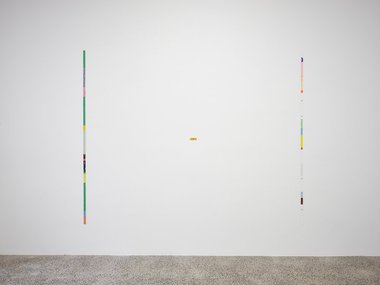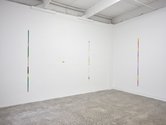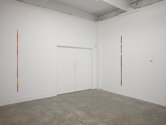John Hurrell – 25 February, 2024
You might legitimately argue that these later works are ‘proper' paintings, whereas the earlier small strips, and the pinned up tiny painted globes too, were a form of conceptual art that half-heartedly denigrated optical enjoyment. I say that because close physical proximity enabled pleasurable visual scrutiny, yet they were akin (but not nearly as extreme) to the early ‘anti-materialist' conceptualist works of American artist Robert Barry who presented inert gas, radio waves, or stretched nylon thread in the gallery space.
Patrick Lundberg characteristically presents two types of work in this exhibition, here as usual interspersed. You could say one is painting, and the other sculpture.
More obvious are the five long vertical strips of painted coton tape, not like earlier smaller works, but now wider and longer. They are not given names that indicate intention, only: No title, and individually, Nos 1, 3, 4, 5 and 8.
In contrast the sculptures lack length or height, but are thick. The small (but not tiny) works consist of three diminutive, boldly decorated horizontal tubes placed on the wall in comparative isolation. They are called No Title Nos. 2, 6, and 7. They are compact and only a few inches long.
Of the paintings, each long, very skinny, vertical flat rectangle is methodically divided into colourful sections that have linear patterns superimposed on top. Whilst their slim sliverlike shapes (read as slots in the wall) are linked to Minimalism and say the ‘zips’ of Barnet Newman, the ornamentation within them can be linked to Matisse and the later Pattern and Decoration movement.
These recent versions are a lot bigger and more imposing than the earlier ‘bootlace’ variations, having more substance in surface area and weight of chroma. Therefore, being more muscular and palpable than before, they are less prone to hazy evanescence caused by the pressuring dominant white walls-though when you stand well back it still occurs.
You might legitimately argue that these later works are ‘proper’ paintings, whereas the earlier small strips, and the pinned up tiny painted globes too, were a form of conceptual art that half-heartedly denigrated optical enjoyment. I say that because close physical proximity enabled pleasurable visual scrutiny, yet they were akin (but not nearly as extreme) to the early anti-materialist (and so anti-visual) conceptualist works of American artist Robert Barry who presented inert gas, radio waves, or stretched nylon thread in the gallery space. The current display follows the historic trajectory of Lundberg’s pinned-up tiny globes with their uber-fine squiggles, occasional letter and minuscule dots.
The three small tubular sculptures present are also intriguing. They could be gaily decorated conduits or pipes used for conveying liquids or gases unknown, signalling exuberant pleasure in their potential acts of transmission—effectively functioning in either direction—enabling inhalation or exhalation. Or they might be perceived as curved rectangular paintings that finish at the left and right ends, are non-functional, but flow on hidden joined-up next to the wall. Their ornamentation is not as fine or delicate as the flat strips but more beefy, less intricate and engaging with what might be present along their unseen backs.
That imagined unseen of possible marks—it might be claimed—is more exhilarating than the visible.
John Hurrell




![Patrick Lundberg, No title [1], 2023, acrylic on cotton tape, 2345 x 26 mm.](/media/thumbs/uploads/2024_02/5_no_title_1__jpg_380x125_q85.jpg)
![Patrick Lundberg, No title [1] (detail), 2023, acrylic on cotton tape, 2345 x 26 mm.](/media/thumbs/uploads/2024_02/6_no_title_1_detail__jpg_380x125_q85.jpg)
![Patrick Lundberg, No title [3], 2023, acrylic on cotton tape, 2345 x 26 mm.](/media/thumbs/uploads/2024_02/7_no_title_3__jpg_380x125_q85.jpg)
![Patrick Lundberg, No title [3] (detail), 2023, acrylic on cotton tape, 2345 x 26 mm.](/media/thumbs/uploads/2024_02/8_no_title_3_detail_jpg_380x125_q85.jpg)
![Patrick Lundberg, No title [4], 2023, acrylic on cotton tape, 2345 x 26 mm.](/media/thumbs/uploads/2024_02/9no_title_4_jpg_380x125_q85.jpg)
![Patrick Lundberg, No title [4] (detail), 2023, acrylic on cotton tape, 2345 x 26 mm.](/media/thumbs/uploads/2024_02/10no_title_4_detail_jpg_380x125_q85.jpg)
![Patrick Lundberg, No title [5] 2023, acrylic on cotton tape, 2345 x 26 mm.](/media/thumbs/uploads/2024_02/11_no_title_5_jpg_380x125_q85.jpg)
![Patrick Lundberg, No title [5] (detail), 2023, acrylic on cotton tape, 2345 x 26 mm](/media/thumbs/uploads/2024_02/12_no_title_5_detail_jpg_380x125_q85.jpg)
![Patrick Lundberg, No title [8], 2023, acrylic on cotton tape, 2345 x 26 mm.](/media/thumbs/uploads/2024_02/13_no_title_8_jpg_380x125_q85.jpg)
![Patrick Lundberg, No title [8] (detail), 2023, acrylic on cotton tape, 2345 x 26 mm.](/media/thumbs/uploads/2024_02/14_no_title_8_detail_jpg_380x125_q85.jpg)
![Patrick Lundberg, No title [2], 2022, acrylic on linen and cardboard, 23 x 80 x 23 mm.](/media/thumbs/uploads/2024_02/15_no_title_2_jpg_380x125_q85.jpg)
![Patrick Lundberg, No title [2], 2022, acrylic on linen and cardboard, 23 x 80 x 23 mm.](/media/thumbs/uploads/2024_02/16_no_title_2_again_jpg_380x125_q85.jpg)
![Patrick Lundberg, No title [6], 2022, acrylic on linen and cardboard, 23 x 80 x 23 mm.](/media/thumbs/uploads/2024_02/17_no_title_6_jpg_380x125_q85.jpg)
![Patrick Lundberg, No title [6], 2022, acrylic on linen and cardboard, 23 x 80 x 23 mm.](/media/thumbs/uploads/2024_02/18_no_title_6_again_jpg_380x125_q85.jpg)
![Patrick Lundberg, No title [7], 2024, acrylic on linen and cardboard, 23 x 80 x 23 mm.](/media/thumbs/uploads/2024_02/19_no_title_7_jpg_380x125_q85.jpg)
![Patrick Lundberg, No title [7], 2024, acrylic on linen and cardboard, 23 x 80 x 23 mm.](/media/thumbs/uploads/2024_02/20_no_title_7_again_jpg_380x125_q85.jpg)
 Advertising in this column
Advertising in this column Two Rooms presents a program of residencies and projects
Two Rooms presents a program of residencies and projects



This Discussion has 0 comments.
Comment
Participate
Register to Participate.
Sign in
Sign in to an existing account.